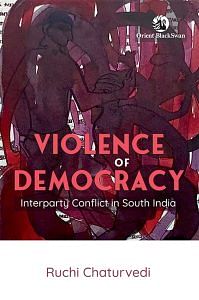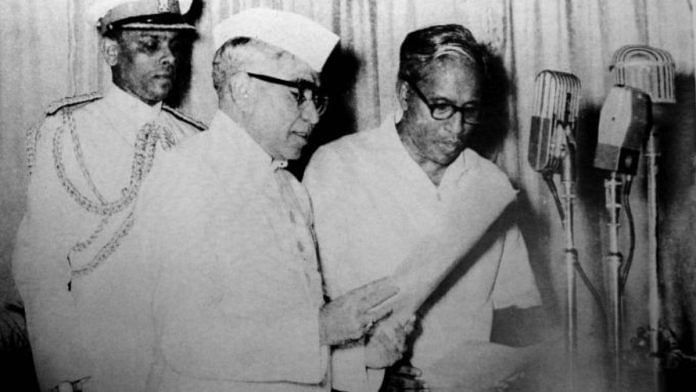In 1954, the psp formed a government in Travancore-Cochin on the back of different interparty alliances after winning only nineteen seats in a legislature made up of 117 members. The psp-led government was dissolved eleven months later due to mishandling of labor disputes and judicial indictment in the wake of police firing on protesters seeking separation of Tamil-speaking areas from the rest of the province.
This made way for the Congress, and subsequently the cpi, to the helm of state government. Leaders of the cpi spent most of the 1950s strengthening their organizational machinery and popular base, as well as entering into a number of alliances to secure electoral victories.
While some leading members continued to harbor reservations about the parliamentary path, the party’s efforts proved to be a spectacular success in 1957 when it won sixty out of the 126 assembly seats (albeit getting only 35.28 percent of the polled votes) and allied with various independent candidates to form the first elected communist government in the world. Here was the chance for the pragmatists in the party to demonstrate all that could be achieved through an elected People’s Democratic Government.
The newly elected cpi ministry braced themselves to fulfill the promises made in its manifesto, ranging from a substantial increase in state spending on new industries, cooperatives, wage increases, and house building to educational and comprehensive agrarian reform. These last two measures, however, became the source for the fall of the communist ministry in Kerala. The government’s efforts to reform private school management, intervene on behalf of schoolteachers, and standardize school curriculums, in particular, incensed Christian religious leaders who described the education bill as an antiminority totalitarian act. Once again there was call for mass action, but this time it was to free the state from the hold of the Communist Party. Similar to the socialist- and communist-led actions of the 1930s and 1940s, this alleged liberation struggle or vimochana samaram was also anchored in a hydraulic understanding of freedom, and its leaders often espoused the overthrow of the communist government through collective acts of aggressive resistance, much like the ones that Gopalan had participated in.
Also read: At least 195 Palestinians killed in Israel’s attacks on Jabalia refugee camp, says Hamas
Massive demonstrations took place in South Kerala in which members of landed upper-caste groups and Christians of different denominations and class backgrounds participated. These protests followed virulent exhortations by Church leaders against the communist government. Landowning members of the Nair community opposed to the proposed agrarian relations bill, and opposition parties such as the Congress and the psp, joined in the protests. Amid calls for the cpi to marshal its own militant members to counter the mobilizations against it, several violent encounters between Communist Party workers and anticommunists ensued.
In one of the worst incidents in Trichur district, six congressmen were killed, and the following year, seventeen people were killed in police firings. Violence thus became closely entwined with the institution of democracy in Kerala. If the pursuit of popular sovereignty generated acts of collective violence, then defense of elected parties and governments produced violence by party workers and police. Strong communitarian response from Church groups, which wrongly or rightly felt minoritized especially characterized this period. Matters came to a head as the conflict between Communist Party members and the anticommunists led to more spectacular public and police violence.
Eventually, in July 1959, Nehru dismissed the elected communist government citing its incapacity to rule according to constitutional provisions. Some authors, including the economist and ex-finance minister of Kerala, Thomas Isaac, have sought to establish American complicity in this chain of events.
These commentators describe the vimochana samaram and the ouster of the communist government as aspects of American policy to, in their words, “contain” communism in Asia. But the cpi was unlike other major communist parties in Asia, and the vimochana samaram became one dramatic episode in its long career. The party had taken to representative democracy and was on its way to becoming a key electoral force.
Also read: Israeli academics defending Palestinian flag shows 2 things. And it should make India envious
Attempts to preserve its position as the duly elected representative of “the people” yielded its workers’ and police violence. In the next elections, the cpi increased its vote share by a fair amount even though it failed to form a government, and once again, psp leader Pattam Thanu Pillai became the chief minister when his party entered into a coalition with the Congress.
North Kerala did not experience the vagaries of the vimochana samaram with the same intensity as some parts of South Kerala. Writing about it several years later in his memoir, with the benefit of hindsight and in the wake of critiques of the Church and Nair leaders of the movement as communal defenders of bourgeois interests, Kurup expressed his disapproval of several aspects of the movement.
Nevertheless, he recounted his participation in vimochana samaram, the jatha he led, how he broke the law against large gatherings that had been imposed at the time, the short speech he gave at the public meeting in Jawaharghat, and his subsequent arrest. Supporters of the psp and Kurup were especially active in the anti-cpi government rallies that were organized at the time. In the 1960 polls that followed, Kurup defeated his Communist Party rival by twenty-nine thousand votes, which was the largest margin of victory that anyone had against a communist candidate in those elections.
 This excerpt from Ruchi Chaturvedi’s Violence of Democracy has been published with publisher Orient BlackSwan.
This excerpt from Ruchi Chaturvedi’s Violence of Democracy has been published with publisher Orient BlackSwan.



